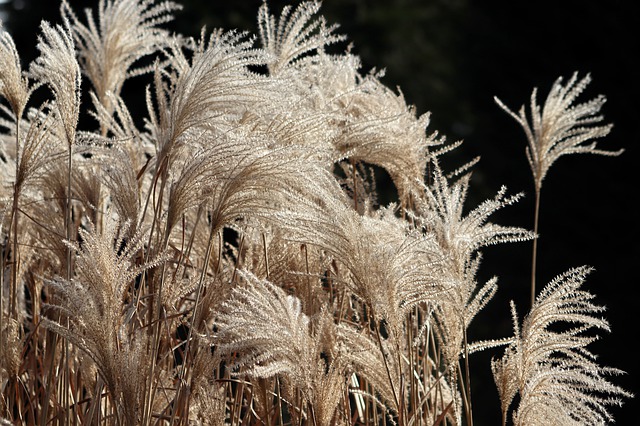Hundreds of hectares of miscanthus – a perennial herbaceous grass native to Africa and South Asia – could be used to manufacture parts for the automotive industry.
The “Biomass for the future” initiative, part of the Investments for the Future Programme (PIA), has been conducting studies to find alternatives to fossil fuel consumption for eight years (1). This programme aims to identify varieties of plants which might be used in the production of bio-energy and bio-materials, once they have been processed. Hemp is currently one of these plants chosen by automotive parts manufacturers to produce parts made from composites.
The automotive manufacturer PSA is a new convert to miscanthus production. Some of its vehicles’ interior components will soon be made from plastic granules combined with miscanthus fibres. These plant-based fibres will replace glass fibres made from fossil fuels.
 As a partner of Biomass for the Future (BFF, see boxed text), part of the Investments for the Future Programme (PIA), PSA approved the composite manufacturing process developed by Addiplast within the framework of BFF. By joining the PIA, PSA made clear its desire to extend the range of equipment made using bio-materials.
As a partner of Biomass for the Future (BFF, see boxed text), part of the Investments for the Future Programme (PIA), PSA approved the composite manufacturing process developed by Addiplast within the framework of BFF. By joining the PIA, PSA made clear its desire to extend the range of equipment made using bio-materials.
In this way, PSA will be able to extend the choice of raw materials used to manufacture interior components for vehicles (dashboards, for example) beyond hemp, as currently used by Faurécia, the French engineering and automotive parts manufacturer. Hemp represents about 20% of the composition of the granules currently produced.
Miscanthus has many potential industrial applications. This versatility has contributed to a boom in miscanthus farming. The canes, which are made from cellulose, are already used in mulching for agricultural, poultry and horticultural applications. They are also used for heating (https://www.france-miscanthus.org/) and electricity cogeneration, in particular in the UK (https://www.terravesta.com). There has also been interest in miscanthus for the production of second-generation ethanol (https://www.grace-bbi.eu/).
Well-adapted to poor soils

Unlike hemp, miscanthus is easier to grow, and its production does not enter into competition with food crops, as it grows well on soils which cannot be used for agricultural production.
On farms, it grows easily on poor soils which are low in nutrients. Miscanthus rhizomes also grow well on old, polluted brownfield sites.
Almost all the nutrients absorbed during the plant’s growth cycle are returned to the soil (when the leaves fall) or migrate to the rhizomes and are stored there. The plants use this store of nutrients to nourish themselves the following spring.
That said, a considerable amount of agricultural land is required to produce automotive parts partially made from miscanthus fibres. According to Herman Höfte, Director of research at the Institut Jean-Pierre Bourgin, INRA-AgroParisTech, 1,230 tonnes of miscanthus, grown on around 125 hectares would be required to equip the two million cars produced in France each year with just two miscanthus composite parts weighing one kilogramme each.
Like for the production of alcohol and for electricity cogeneration, only miscanthus canes, which are made from cellulose, are used to produce the granules, which are a composite of plastic (80%) and fibres (20%). They are harvested once a year, after their leaves fall.
Native to Japan and China
The variety of miscanthus currently farmed is the triploid interspecific hybrid, Miscanthus x giganteus. It is sterile and is propagated using its rhizomes. Establishment costs are around €3,000/hectare. Grown as a perennial crop (20 years), it produces 10 to 30 tonnes of dry matter which sells for up to €100/t. The crop is relatively low maintenance. Thus, amortisation of establishment costs is the main expense for miscanthus farmers.
 In East Asia (China, Korea, Japan), there are many varieties of diploid and tetraploid miscanthus which grow alongside sterile triploid varieties, resulting from natural hybridisation between the diploid and tetraploid varieties.
In East Asia (China, Korea, Japan), there are many varieties of diploid and tetraploid miscanthus which grow alongside sterile triploid varieties, resulting from natural hybridisation between the diploid and tetraploid varieties.
The giganteus triploid variety grown in France is almost identical to the plants of the same variety growing in the wild.
Other varieties of miscanthus can be propagated using seeds, but agronomists fear the invasiveness of the plant if a large quantity of small seeds were to spread without control. Agronomists thus opted for infertile, vegetatively propagated varieties, as these are not invasive.
The PIA BFF research programmes aim to identify specific varieties best suited to the production of substrates, alcohol or, as discussed above, bio-materials. Farmers have partnered with these programmes to study how the different plants being grown will develop on their farms.
The idea is to develop agro-industrial chains similar to sugar or potato starch chains. However, miscanthus processing will not lead to the emergence of a chain of startups, as is the case in other research sectors.
Heavy industry
Like for the sugar beet industry, miscanthus farming has developed in partnership with major industrial groups, and the operations involved in processing the crop require large amounts of capital. Currently, 5,500 hectares are being grown – only enough to produce the equivalent of 40 kg of parts, 20% of which are made from fibres, in each of the 2 million cars produced every year in France. But these 5,500 hectares are already reserved for current uses (combustion, mulching).
However, a partnership of 25 miscanthus producers, Biomasse Environnement Systèmes SAS (http://bes-site.fr/miscanthus) is setting up facilities to carry out the first step of processing the crop on their farms. This involves grinding the harvested miscanthus canes and delivering the raw material to companies ready for energy production or to enter into the production of granules delivered to Addiplast.
Other farmers could follow this path by setting up similar companies to organise and regulate the “Miscanthus” chain and give new planters access to the financial resources to establish the crop on their plots.
The PIA BFF brings together public research centres (INRA, CIRAD and the Ecole des Mines) and private partnerships.
Frédéric Hénin
Research teams also bring farmers on board to study the behaviour and the development of plants on their soil. Miscanthus, along with sorghum and maize, is one of the plants chosen by the PIA “Biomass for the future” programme.
It is a crop for our times. It requires few agricultural inputs to grow. The leaves which fall to the ground make a mulch which enriches the soil with organic carbon. And the carbon footprint of the bio-materials is small.
(1) https://www6.inra.fr/biomassforthefuture



